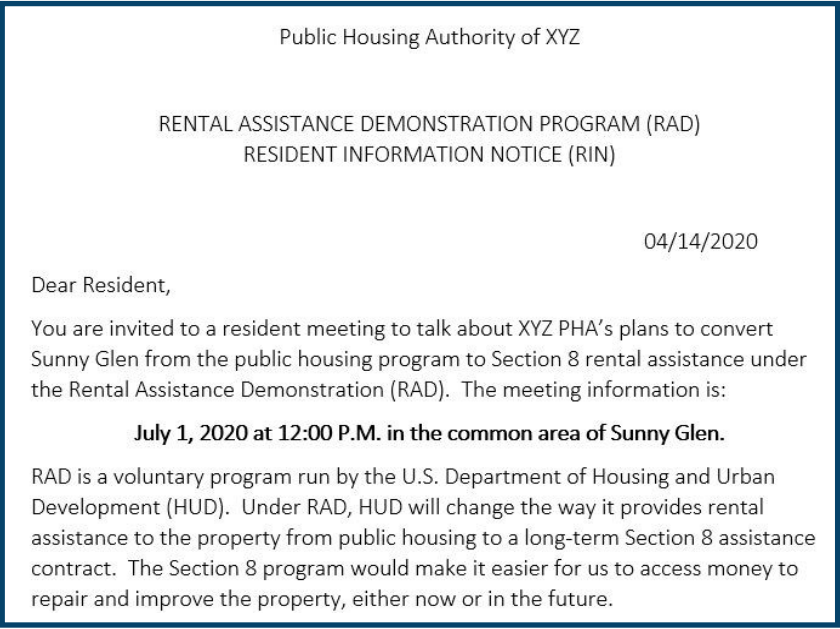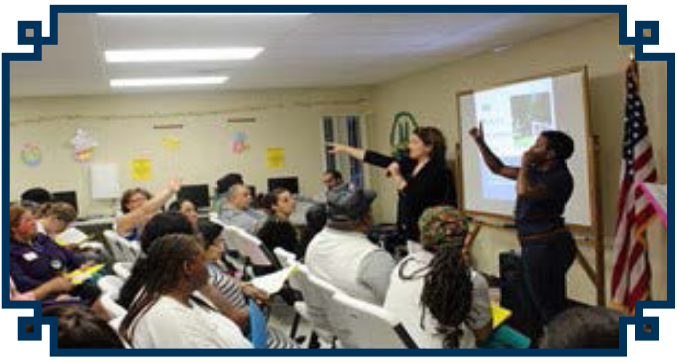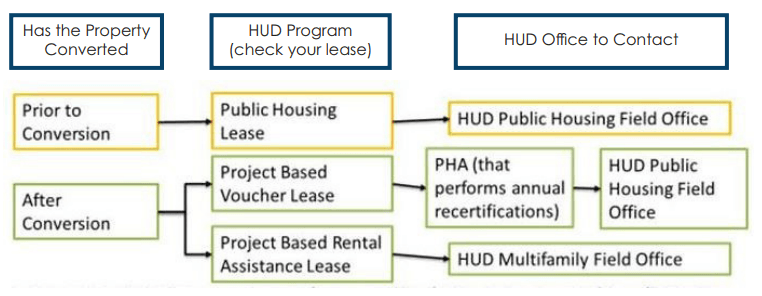RAD RESIDENT RIGHTS In Public Housing
What’s Inside?
| Right to Notice | 2 |
|---|---|
| Right to Comment | 2 |
| Relocation Rights | 3 |
| Right to Return | 3 |
| Choice Mobility | 3 |
| Resident Organizations | 4 |
| Monitoring Progress | 4 |
Know your Rights
As a resident of a public housing property that is participating in RAD you
have the following rights:
Prior to conversion
- Receive notice and participate in meetings
- Comment on the conversion plans
At conversion
- To maintain residency in the property
- If temporary relocation is necessary, you are provided relocation protections and a right to return
After conversion:
- Pay no more than 30% of adjusted income in rent
- Right to participate in a resident organization.
- Right to exercise “ChoiceMobility”
- Your lease must be renewed and you cannot be evicted without cause
- Right to termination and grievance procedures.
What is RAD?
Public Housing Agencies (PHAs) use the Rental Assistance Demonstration (RAD) Program to preserve affordable housing and improve properties by “converting” their form of federal assistance to the Section 8 program. PHAs choose to convert to either: Section 8 project-based voucher (PBV) or Section 8 project-based rental assistance (PBRA).
PBV and PBRA both attach long-term rental assistance to properties, so current and future residents never pay more than 30% of their adjusted gross income (total income minus allowable deductions) in rent. After a property converts to PBV or PBRA, your public housing lease ends and you will sign a Section 8 lease with the “owner” who in many cases will continue to be the PHA. You will still have the same core rights that you have as a public housing tenant but will also gain new rights and protections under RAD.
This brochure provides greater detail on each of the resident rights and protections that HUD requires as a public housing property converts through RAD.
Key Preservation Principles of RAD
| Conversion is Voluntary | Public housing agencies (PHAs) voluntarily choose to convert a public housing property through RAD in order to preserve, repair, and in some cases, redevelop the property. |
|---|---|
| Property Improvements | PHAs must show HUD that the property will address any repair needs and remain in good condition after conversion. |
| One-for-one Replacement | PHAs must preserve the same number of affordable dwelling units (with minor allowances for reductions). |
| Long-term Preservation | The property must be placed under a long term Section 8 assistance contract that must renew each time it expires. |
| Public Stewardship | Properties must be owned or controlled by a public or non-profit body after RAD conversion. |
PHA Conversion Process
Construction
(if applicable)
Repairs/ construction
completed. Residents temporarily relocated, if needed
Residents can ask about impacts to their rent, repairs on the property, and whether there will be relocation. Participating in resident
meetings throughout the RAD process is the best way to ensure your voice is heard
Pre-Conversion: Resident Notification
Residents have a right to be notified of project plans and any potential changes. Before submitting a RAD application to HUD, PHAs must issue a written notification to resident organizations and issue a Resident Information Notice (RIN) to each resident. The RIN will describe the PHA’s initial conversion plans and will notify you of the first resident meeting, where RAD resident rights and project plans will be discussed in detail. A PHA must hold at least two resident meetings before submitting its application.
Read all notices! All residents will receive a RIN.
A GIN is issued when a household could be relocated.
Relocation is generally not required during a RAD conversion, but if it is part of the plan, a PHA must issue a General Information Notice (GIN), which includes your rights under RAD and a law called the Uniform Relocation Assistance and Real Property Acquisitions Act (URA), which gives residents rights to relocation assistance.
When HUD issues a RAD Conversion Commitment (RCC), the PHA must notify residents that conversion has been approved and address anticipated timing, duration, revised terms of the lease and house rules, any anticipated relocation, and opportunities and procedures for the exercise of choice mobility, when available.
All materials must be accessible to those with hearing, visual, and other communication-related disabilities and to those with limited English proficiency.
Pre-Conversion: Resident Engagement
After PHAs hold two resident meetings and submit a RAD Application, HUD issues a Commitment to Enter into Housing Assistance Payments (CHAP), which serves as an initial award. The PHA then proceeds to develop a more robust conversion plan. A PHA must have at least one meeting with residents after a CHAP is issued, but before requesting a Concept Call with HUD, when it will describe its progress towards submitting a Financing Plan. After the Concept Call, but before submission of a Financing Plan, the PHA must have an additional resident meeting. At each of these resident meetings, the PHA will discuss conversion plans, respond to questions, and collect resident feedback. Residents and resident organizations are encouraged to meet prior to resident meetings to organize questions and feedback. PHAs are required to hold additional resident meetings when there are substantial changes to conversion plans or when HUD grants the PHA extensions.
A PHA must prepare comprehensive written responses to resident comments collected during resident meetings. HUD reviews resident comments and concerns when deciding whether to grant an (RCC), which is the step before the RAD transaction reaches the final stage—closing.
PHA Plan. Note that in addition to meeting with residents of the converting project, a PHA must also amends its PHA Plan to reflect the proposed RAD conversion and solicit community input. As part of this process, a PHA will hold separate public meetings and collect comments
Residents should ask about any impacts converting to Section 8 may have on their rent, repairs that might be done on the property, and whether residents will need to be relocated temporarily.
Right to Remain and Return
No resident may be permanently involuntarily displaced. All residents must be offered the ability to remain in or, if temporary relocation is necessary, to return to the property: Residents who are not asked to relocate have a right to remain at the property. If you are temporarily relocated, you have a right to return to the property. A PHA may choose to offer residents alternative housing options, instead of returning to the property. It is fully your choice whether or not to accept an alternative housing option. You cannot be denied your right to remain in or return to a property based on any HUD re-screening criteria, income eligibility, or income targeting. The unit you return to must not leave you “underhoused,” meaning the unit must have at least the number of bedrooms you are allowed under the PHA’s rules. The new unit must also provide the same main features of your previous unit.
In some RAD conversions, the assistance is transferred to a new site. In these cases, residents have the right to reside in a unit at the new site.
Right to Relocation Assistance
Most RAD conversions do not require relocation, but if relocation is necessary, residents will receive an early indication through a General Information Notice (GIN) at the CHAP phase. The GIN is not your notice to relocate. If you must relocate, you will receive separate notices and have further discussions with the PHA to go over relocation options and process.
Relocation can take many forms. Residents can relocate within the property or may be temporarily relocated off-site. Alternatively, a resident may accept a PHA’s offer for a permanent off-site housing option. In all cases, the PHA must cover reasonable packing and moving expenses, any increases in housing costs, and other related expenses.
If you must relocate, you will receive a separate “Notice of Relocation.” The Notice of Relocation will provide a time frame for when relocation may occur — at least 30 days for relocation that will last for a year or less or at least 90 days for relocation that will last more than a year. Except in extraordinary circumstances, relocation cannot occur prior to the issuance of the RAD Conversion Commitment (RCC).
Relocations lasting more than a year are subject to special provisions under the Uniform Relocation Act which require relocation assistance and benefits, including relocation advisory services.
Option to Move With a Voucher (“Choice-Mobility”)
After living in the property for a certain period, residents of a RAD PBV or PBRA property have the option to request a tenant-based voucher in order to move from the property and rent a unit in another property. This option is referred to as “Family Right To Move” in your lease. It is the resident’s decision whether or not to exercise this option.
For conversions to PBV, residents may request to move with a voucher anytime after living at the property for one year. When you wish to exercise this “choice-mobility” option, you will contact your PHA to request a tenant-based voucher.
If a voucher is not immediately available, your family is given priority to receive the next available voucher.
A PHA will pay for reasonable increases in housing costs, packing and moving assistance, and reasonable costs associated with transferring utilities
and associated deposits.
After living at the property for a period, a
resident may elect to move out with a tenant-based voucher in order to move closer to a job, family, better schools, or any other reason.
Email questions and comments directly to HUD at: rad@hud.gov
Preserving and improving affordable housing across America
Residents and resident organizations are
encouraged to use resource desk data
Ongoing Right to Participate in a Resident Organization
RAD residents have the right to establish and operate a resident organization that addresses issues related to the living environment, including the terms and conditions of residency, and activities related to housing and community development. Resident organizations are independent from management, meet regularly, operate democratically, and represent all residents. If your property does not have a resident organization, owners must allow residents and outside resident organizers to conduct activities that include distributing leaflets, knocking on doors, and otherwise making contact with residents. Owners must reasonably make available on-site space for resident meetings, which must be accessible to people with disabilities. Finally, Owners must make available at least $25 per unit per year for resident participation activities, including resident education, organizing around tenancy issues, and training. At least $15 per unit per year must be made available to the resident organization for eligible activities.
Ongoing Right to Grievance Procedures
Owners must provide residents advanced written notification of any lease termination. Further, residents have a right to address disputes, grievances, and adverse actions taken by an owner. Residents must be provided with notice of the reasons for any a proposed adverse action, an opportunity for an informal hearing, and a written decision within a reasonable time-frame.
Informal hearings at PBV properties are performed by the PHA, while hearings at
PBRA properties are performed by an impartial member of the project owner’s staff. The grievance process must be outlined in your lease.
Need More Information?
Typically, the best place to start when you have questions or issues related to a RAD conversion is to have a discussion with your property manager or PHA. However, there are other resources residents may access to gather additional information:
- Find resources at www.hud.gov/RAD/residents
- Email RAD@hud.gov
- Use www.radresource.net to track the status of RAD projects. By accessing the “DATA” spoke on the “RAD for PHAs” part of the site (pictured), users can create custom data exports, searchable by state or PHA
- If your question or issue is not adequately addressed, you can seek additional assistance. The appropriate HUD contact will depend on what program your property falls under: public housing, Project-Based Voucher, or Project Based Rental Assistance. If you’re not sure, check your lease. The graphic below identifies which HUD office is most appropriate.
PHONE: 417-866-4329 | EMAIL: hasoffice@hasproperties.org
ADDRESS: 421 W. Madison St. Springfield, MO 65806




